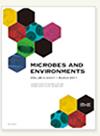泥沙盆地回用土壤对白菜黄萎病风险评价
IF 2
4区 环境科学与生态学
Q3 BIOTECHNOLOGY & APPLIED MICROBIOLOGY
引用次数: 0
摘要
白菜田对底泥盆地土壤的回用需求日益增长;然而,重复使用土壤会带来潜在的挑战,即黄萎病通过病原体侵染的沉积物传播到田间。采用巢式实时定量聚合酶链反应法测定沉积盆地土壤中黄萎病病原菌的密度,采用盆栽试验测定其发病率。我们在沉积物中检测到较低的致病DNA水平,再加上盆栽试验中黄萎病的发病率和严重程度较低,表明黄萎病在沉积物盆地土壤的重复利用中传播的风险较低。本文章由计算机程序翻译,如有差异,请以英文原文为准。
Risk Evaluation of Verticillium Wilt on Cabbage Grown in Soil Reused from Sediment Basins.
There is a growing demand for the reuse of sediment basin soil in cabbage fields; however, reusing soil poses a potential challenge of spreading Verticillium wilt to the fields via pathogen-infested sediments. We evaluated the density of the Verticillium wilt pathogen in sediment basin soil using a quantitative nested real-time polymerase chain reaction assay and its incidence using pot cultivation tests. We detected low pathogenic DNA levels in the sediment, coupled with a low Verticillium wilt incidence and severity in the pot experiment, indicating a low risk of spreading Verticillium wilt with the reuse of sediment basin soil.
求助全文
通过发布文献求助,成功后即可免费获取论文全文。
去求助
来源期刊

Microbes and Environments
生物-生物工程与应用微生物
CiteScore
4.10
自引率
13.60%
发文量
66
审稿时长
3 months
期刊介绍:
Microbial ecology in natural and engineered environments; Microbial degradation of xenobiotic compounds; Microbial processes in biogeochemical cycles; Microbial interactions and signaling with animals and plants; Interactions among microorganisms; Microorganisms related to public health; Phylogenetic and functional diversity of microbial communities; Genomics, metagenomics, and bioinformatics for microbiology; Application of microorganisms to agriculture, fishery, and industry; Molecular biology and biochemistry related to environmental microbiology; Methodology in general and environmental microbiology; Interdisciplinary research areas for microbial ecology (e.g., Astrobiology, and Origins of Life); Taxonomic description of novel microorganisms with ecological perspective; Physiology and metabolisms of microorganisms; Evolution of genes and microorganisms; Genome report of microorganisms with ecological perspective.
 求助内容:
求助内容: 应助结果提醒方式:
应助结果提醒方式:


